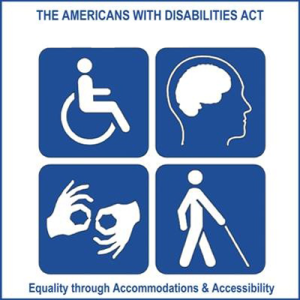The Americans with Disabilities Act
 The Americans with Disabilities Act (ADA) is the most comprehensive federal civil-rights statute protecting the rights of people with disabilities. It affects access to employment; state and local government programs and services; access to places of public accommodation such as businesses, transportation, and non-profit service providers; and telecommunications.
The Americans with Disabilities Act (ADA) is the most comprehensive federal civil-rights statute protecting the rights of people with disabilities. It affects access to employment; state and local government programs and services; access to places of public accommodation such as businesses, transportation, and non-profit service providers; and telecommunications.
The scope of the ADA in addressing the barriers to participation by people with disabilities in the mainstream of society is very broad. The ADA’s civil rights protections are parallel to those that have previously been established by the federal government for women and racial, ethnic and religious minorities.
“The ADA is solely about ‘equal opportunity’, from its preamble to its final provision: like other civil rights laws, the ADA prohibits discrimination and mandates that Americans be accorded equality in pursuing jobs, goods, services and other opportunities — but the ADA makes clear that equal treatment is not synonymous with identical treatment, says Professor Robert Burgdorf Jr., one of the drafters of the original bill that became the ADA.
“Letting every employee have an identical opportunity to use a restroom located up a flight of stairs may be ‘identical’treatment but it is hardly equal treatment for a worker who uses a wheelchair.
“The ADA is a mandate for equality. Any person who’s discriminated against by an employer because of a real disability — or because the employer regards the person as being disabled, whether they are or not — should be entitled to the law’s protection. The focus of the Act was — and should be — on eliminating employers’ practices that make people unnecessarily different.” Progress at 10 years
Ten years after the signing of the Americans with Disabilities Act in 1990, this landmark federal law has proved a remarkable success, defying the gloom and doom predictions of many members of Congress that the law, designed to open up American society to its 54 million citizens with disabilities, would bankrupt the economy. At the same time however, the law has not fully delivered on its keys promises to eliminate discrimination against people with disabilities in the workplace and in public accommodations.
The ADA has profoundly changed how society views and accommodates its citizens with disabilities. Universal design — the practice of designing products, buildings and public spaces and programs to be usable by the greatest number of people — has helped create a society where curb cuts, ramps, lifts on buses, and other access designs are increasingly common. In the process, we have discovered that an accessible society is good for everyone, not just people with disabilities.
Curb cuts designed for wheelchair users are also used by people with baby carriages, delivery people, and people on skateboards and roller blades. With the Baby Boom generation poised to enter the population of seniors, the number of Americans needing access and universal design will grow enormously.
The ADA has created a more inclusive climate where companies, institutions, and organizations are reaching out far more often to people with disabilities. Colleges and universities, for example, now accommodate more people with disabilities than they did before ADA, even though they have been obligated by law for nearly 25 years to make their campus and classrooms accessible.
June 20, 2014
